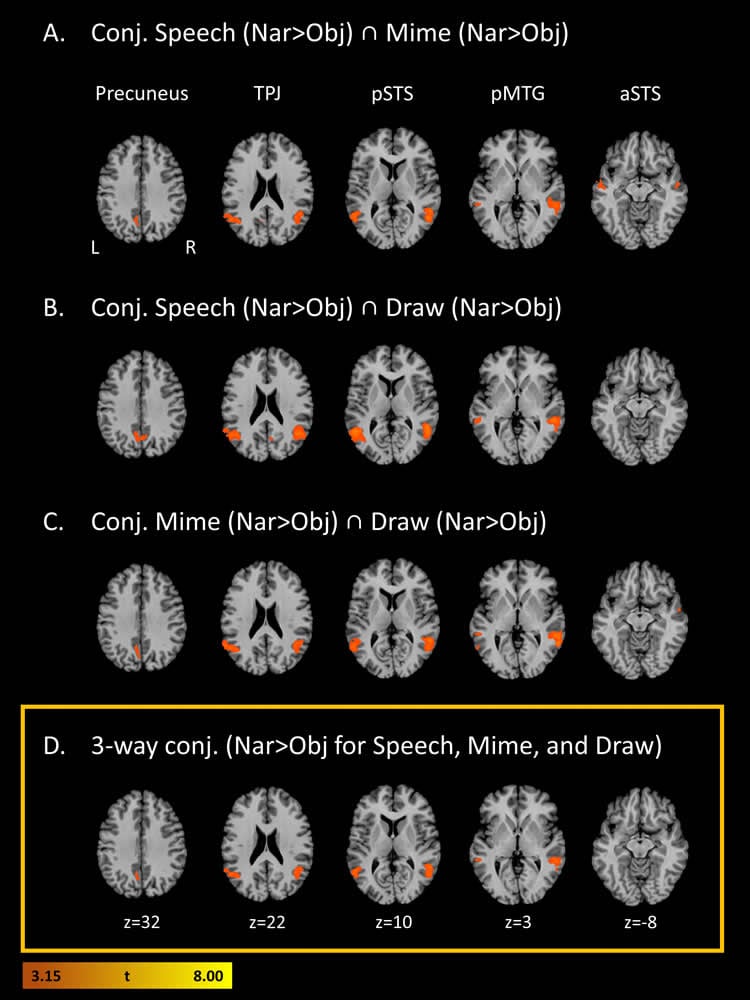Summary: A new neuroimaging study sheds light on how we relate to characters in stories. Researchers report, no matter how a story is relayed, brain networks associated with theory of mind are activated when participants associate with the protagonist. The study concludes our brains relate best to characters, no matter how the narrative is expressed.
Source: McMaster University.
For thousands of years, humans have relied on storytelling to engage, to share emotions and to relate personal experiences. Now, psychologists at McMaster University are exploring the mechanisms deep within the brain to better understand just what happens when we communicate.
New research published in the Journal of Cognitive Neuroscience, suggests that no matter how a narrative is expressed—through words, gestures or drawings—our brains relate best to the characters, focusing on the thoughts and feelings of the protagonist of each story.
“We tell stories in conversation each and every day,” explains Steven Brown, lead author of the study, who runs the NeuroArts Lab at McMaster and is an associate professor in the Department of Psychology, Neuroscience ang Behaviour. “Very much like literary stories, we engage with the characters and are wired to make stories people-oriented.”
An important question researchers set out to answer was how, exactly, narrative ideas are communicated using three different forms of expression, and to identify a so-called narrative hub within the brain.
For the study, researchers scanned the brains of participants using fMRI and presented them with short headlines. For example, “Surgeon finds scissors inside of patient” or “Fisherman rescues boy from freezing lake.”
They were then asked to convey the stories using speech, gestures or drawing, as one would do in a game of Pictionary. The illustrations were created using an MRI-compatible drawing tablet which allowed the participants to see their drawings.

Researchers found that no matter what form of story telling the participants used, the brain networks that were activated were the “theory-of-the-mind” network, which is affected by the character’s intentions, motivations, beliefs, emotions and actions.
“Aristotle proposed 2,300 years ago that plot is the most important aspect of narrative, and that character is secondary,” says Brown. “Our brain results show that people approach narrative in a strongly character-centered and psychological manner, focused on the mental states of the protagonist of the story.”
Next, researchers hope to compare narration and acting to determine what happens when we tell stories in the third-person or portray characters in the first-person.
Source: Michelle Donovan – McMaster University
Publisher: Organized by NeuroscienceNews.com.
Image Source: NeuroscienceNews.com image is credited to McMaster University.
Original Research: Abstract for “Storytelling Is Intrinsically Mentalistic: A Functional Magnetic Resonance Imaging Study of Narrative Production across Modalities” by Ye Yuan, Judy Major-Girardin, and Steven Brown in Journal of Cognitive Neuroscience. Published September 2018.
doi:10.1162/jocn_a_01294
[cbtabs][cbtab title=”MLA”]McMaster University”The Art of Storytelling: Why We Relate to Characters.” NeuroscienceNews. NeuroscienceNews, 13 September 2018.
<https://neurosciencenews.com/character-storytelling-9857/>.[/cbtab][cbtab title=”APA”]McMaster University(2018, September 13). The Art of Storytelling: Why We Relate to Characters. NeuroscienceNews. Retrieved September 13, 2018 from https://neurosciencenews.com/character-storytelling-9857/[/cbtab][cbtab title=”Chicago”]McMaster University”The Art of Storytelling: Why We Relate to Characters.” https://neurosciencenews.com/character-storytelling-9857/ (accessed September 13, 2018).[/cbtab][/cbtabs]
Abstract
Storytelling Is Intrinsically Mentalistic: A Functional Magnetic Resonance Imaging Study of Narrative Production across Modalities
People utilize multiple expressive modalities for communicating narrative ideas about past events. The three major ones are speech, pantomime, and drawing. The current study used functional magnetic resonance imaging to identify common brain areas that mediate narrative communication across these three sensorimotor mechanisms. In the scanner, participants were presented with short narrative prompts akin to newspaper headlines (e.g., “Surgeon finds scissors inside of patient”). The task was to generate a representation of the event, either by describing it verbally through speech, by pantomiming it gesturally, or by drawing it on a tablet. In a control condition designed to remove sensorimotor activations, participants described the spatial properties of individual objects (e.g., “binoculars”). Each of the three modality-specific subtractions produced similar results, with activations in key components of the mentalizing network, including the TPJ, posterior STS, and posterior cingulate cortex. Conjunction analysis revealed that these areas constitute a cross-modal “narrative hub” that transcends the three modalities of communication. The involvement of these areas in narrative production suggests that people adopt an intrinsically mentalistic and character-oriented perspective when engaging in storytelling, whether using speech, pantomime, or drawing.






